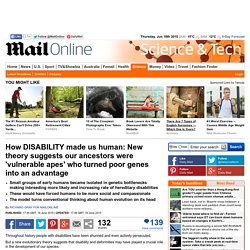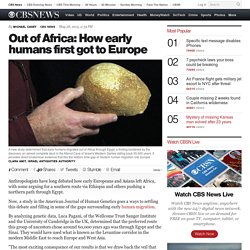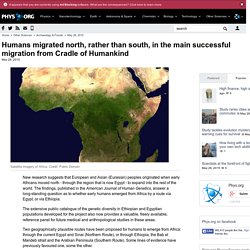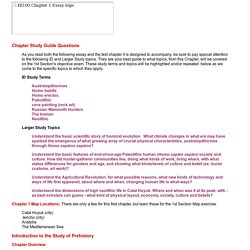

Collection 2. Ancient stone tools hint at first division of labor. Above, two stone tool points made using a prismatic blade technique (left and center), and a bone point or needle (right).

The finds "give us a new window onto a transitional time, on the cusp of modern human cultural behaviors," says anthropologist Aaron Stutz. Thousands of stone tools from the early Upper Paleolithic, found in a cave in Jordan, reveal clues about how humans may have first organized into more complex social groups depending on their technical skills. “We have achieved remarkably accurate estimates of 40,000 to 45,000 years ago for the earliest Upper Paleolithic stone tools in the Near East,” says Aaron Stutz, associate professor at Emory University’s Oxford College. “Our findings confirm that the Upper Paleolithic began in the region no later than 42,000 years ago, and likely at least 44,600 years ago.” The rich array of artifacts shows a mix of techniques for making points, blades, scrapers, and cutting flakes. Population mix Family life. DISABILITY made us human: New vulnerable ape theory suggests our ancestors turned poor genes into an advantage. Small groups of early humans became isolated in genetic bottlenecks making inbreeding more likely and increasing rate of hereditary disabilitiesThese would have forced humans to be more social and compassionateThe model turns conventional thinking about human evolution on its head By Richard Gray for MailOnline Published: 17:46 GMT, 16 June 2015 | Updated: 17:46 GMT, 16 June 2015 Throughout history people with disabilities have been shunned and even actively persecuted.

But a new evolutionary theory suggests that disability and deformities may have played a crucial role in the development of our species. Anthropologists at the University of York and Newcastle University believe hereditary disabilities may have forced early humans to become more social and cooperative. They claim our ancestors faced genetic bottlenecks at key moments in our evolutionary history, where small groups became isolated, making inbreeding more likely. 3 Simple Tools to Create Quote Posters for Your Class. May 29, 2015 Below are three of our favourite web tools for creating picture quotes.

You can use these tools with your students to create beautiful quote posters for your class. These picture quotes can be used as warm-up activities or entry events to project based learning. They could also serve as prompts to brainstorm ideas around a given topic or as educational posters to embellish your classroom walls with nuggets of wisdom. 1- PixTeller “PixTeller is a new and simple way to make beautiful posters and to share them with your friends and family.
Ethiopian and Egyptian genomes help map early humans' route out of Africa. Posted by TANNAnthropology, ArchaeoHeritage, Archaeology, Breakingnews, Early Humans, Genetics10:00 PM Although scientists are confident that all modern human populations can trace their ancestry back to Africa, the route taken out of Africa is still unclear.

New genomic analyses of people currently living in Ethiopia and Egypt indicate that Egypt was the major gateway out of Africa and that migration followed a northern rather than a southern route. The findings, which appear in the American Journal of Human Genetics, add a crucial piece of information to help investigators reconstruct humans' evolutionary past.
To uncover the migratory path that the ancestors of present-day Europeans and Asians (Eurasians) took when moving out of Africa around 60,000 years ago, Dr. Out of Africa: How early humans first got to Europe. A new study determined that early humans migrated out of Africa through Egypt, a finding bolstered by the discovery an almost complete skull in the Manot Cave of Israel's Western Galilee dating back 55,000 years.

It provides direct anatomical evidence that fills the historic time gap of modern human migration into Europe. Clara Amit, Israel Antiquities Authority Anthropologists have long debated how early Europeans and Asians left Africa, with some arguing for a southern route via Ethiopia and others pushing a northern path through Egypt. Now, a study in the American Journal of Human Genetics goes a ways to settling this debate and filling in some of the gaps surrounding early human migration. By analyzing genetic data, Luca Pagani, of the Wellcome Trust Sanger Institute and the University of Cambridge in the UK, determined that the preferred route this group of ancestors chose around 60,000 years ago was through Egypt and the Sinai.
Humans migrated north, rather than south, in the main successful migration from Cradle of Humankind. New research suggests that European and Asian (Eurasian) peoples originated when early Africans moved north - through the region that is now Egypt - to expand into the rest of the world.

The findings, published in the American Journal of Human Genetics, answer a long-standing question as to whether early humans emerged from Africa by a route via Egypt, or via Ethiopia. The extensive public catalogue of the genetic diversity in Ethiopian and Egyptian populations developed for the project also now provides a valuable, freely available, reference panel for future medical and anthropological studies in these areas. Two geographically plausible routes have been proposed for humans to emerge from Africa: through the current Egypt and Sinai (Northern Route), or through Ethiopia, the Bab el Mandeb strait and the Arabian Peninsula (Southern Route). Did sexual equality fuel the evolution of human cooperation? When a massive earthquake struck Nepal 3 weeks ago, people around the world flooded the country with donations and other offers of support.

Humans are among the most cooperative animals on the planet, yet scientists are unclear about how we got this way. A new study suggests the answer may be gender equality: When men and women have equal say in who they associate with, our social networks get larger. Anthropologists used to think that we grew our social networks by associating with people who were genetically related to us. Families moved in with grandparents and cousins, who themselves lived close to other relatives.
Study Shows Gender Equality Prevailed Among Prehistoric People. A review by anthropologists of the way gatherer-hunter societies are organized in our own time suggests that the gender inequality observed today did not exist for the vast majority of our evolutionary history and that prehistoric societies were fundamentally egalitarian.

Science correspondent Hannah Devlin writes at The Guardian: “A study has shown that in contemporary hunter-gatherer tribes, men and women tend to have equal influence on where their group lives and who they live with. The findings challenge the idea that sexual equality is a recent invention, suggesting that it has been the norm for humans for most of our evolutionary history.” Devlin quotes Mark Dyble, an anthropologist who led the study at University College London, as saying: “There is still this wider perception that hunter-gatherers are more macho or male-dominated.
We’d argue it was only with the emergence of agriculture, when people could start to accumulate resources, that inequality emerged.” More Below the Ad. Scientists unearth earliest-known stone tools, 3.3 million years old. Scientists working in Kenya have unearthed the oldest known stone tools, simple cutting and pounding implements crafted by ancient members of the human lineage 3.3 million years ago.

At about 700,000 years older than the other stone tools excavated to date, the discovery hints that anthropologists may have had the wrong idea about the evolution of humans and technology, said Stony Brook University archeologist Jason Lewis, coauthor of a study describing the find published Wednesday in the journal Nature. Traditionally, Lewis said, scientists believed that stone tool-making emerged with the first members of our own large-brained genus, Homo, as they fanned out into savanna grassland environments about 2.5 million years ago. Islamic State bans archaeology due to fears of idol worship. Chapter 1 Instructor's Essay: Prehistory. Understand the basic scientific story of hominid evolution What climate changes in what era may have sparked the emergence of what growing array of crucial physical characteristics, australopithicines through Homo sapiens sapiens?

Understand the basic features of end-of-ice-age Paleolithic human (Homo sapien sapien) society and culture. How did hunter-gatherer communities live, doing what kinds of work, living where, with what status differences for genders and age, and showing what kinds/levels of culture and belief (ex: burial customs, art work)? The First Towns: Seedbeds Of Civilization.
AP World History Unit 1 Assessment Notes: The Agricultural Revolution flashcards. The Origins of Civilization, Gil Stein. 2 of 2 Chronology of the “Neolithic Revolution”: The Neolithic revolution took place in several stages. First, people settled down in permanent communities (“sedentism”), and afterwards they developed food production. Paleolithic – before 10,000 BCE – nomadic hunter-gathers of the Pleistocene (Ice Age) Epipaleolithic – Natufian Culture ca. 10,000-8300 BCE – sedentary hunter-gatherers Pre-Pottery Neolithic A (PPNA) – 8300-7500 BCE – domestication of wheat, barley Pre-Pottery Neolithic B (PPNB) – 7500-6000 BCE – domesticated sheep, goats, cattle, pigs Once people had developed a village farming system based on both domesticated plants and animals, the Neolithic economy spread across the Middle East. The Environmental Context of the Neolithic “Revolution” During the Pleistocene, climatic conditions in the Middle East were much colder and drier than they are today.
The Epipaleolithic Period and the Natufian Culture of the Levant (10,000–8300 BCE) 1. Framing the Issues. Neolithic Revolution. "The Agrarian Revolution and the Birth of Civilization" Peter N. Stearns, Michael Adas, Stuart B. Plant Domestication. Agricultural Revolution. Ancient Culture Agricultural Revolution Emergence of Agriculture, Ancient Times Inevitably, these methods of hunting and gathering would not prove to be lucrative enough for the nomads, so they were forced to turn to anther method of survival. Within the last 11,000 years, some peoples turned to more modern food production: domesticating wild animals and plants and eating the resulting livestock and crops. As humans spread the globe, game resources in the favorable regions were declining and hunters/gatherers were required to formulate another method of keeping themselves fed. National Geographic: Massive Genetic Study Supports "Out of Africa" Theory.
Out of Africa Replace or Amixture. Out of Africa and Economics. Genetic Origins. Out of Africa Theory. Investigating Our Past: Where Did Humans Come From? New Study says early humans migrated into Europe due to warming climate. Rising temperatures approximately 1.4 million years ago might have assisted the migration of hominins out of Africa and into Europe, a new study suggests. Dr. Jordi Agustí and colleagues have published a study in the Journal of Human Evolution that argues that prehistoric climate change affected the location and amount of resources available to our early ancestors. These early humans are thought to have benefited from shifting climate patterns, as the warming environment facilitated migration and access to food.
World's oldest tools discovery may rewrite evolutionary history. Archaeologists have found 20 stones shaped by early humans using 'simple techniques' close to the west shore of Lake Turkana in KenyaThe tools are thought to be 500,000 years older than the first Homo speciesThey are also 700,000 years older than other stone tools found previouslyScientists say it could reshape ideas about how our own species evolved By Richard Gray for MailOnline Published: 12:35 GMT, 15 April 2015 | Updated: 16:46 GMT, 15 April 2015 A set of stone flakes shaped more than 3.3 million years ago could be the world's oldest tools created by early human ancestors, according to researchers.
Archaeologists have revealed that they have discovered 20 stone flakes and anvils - used to help shape the tools - just west of Lake Turkana in Kenya. World's Oldest Stone Tools Found in Africa - D-brief. Neolithic bling and the spread of farming in Europe. The adoption of farming has completely and definitively changed the relation between humans and nature.
For the first time, by putting nature at their service through the development of a production economy, humans became the masters of their own destiny. Paleolithic Era vs Neolithic Era quiz flashcards. 34 minutes on Paleolithic Era. The paleolithic era and the neolithic era. An Overview of the Paleolithic. Paleolithic - Study Guide and Chronology of the Paleolithic. Neolithic Europe's Remote Heart. In 2002, Ola and Arnie Tait decided they wanted to change the view from their kitchen window. Rather than staring at a sheep pasture, they envisioned looking out onto a wildflower meadow full of poppies, cornflowers, buttercups, and singing birds. The Neolithic Revolution. A Settled Life. The Agricultural Revolution. Return to Sociology Timeline. Wealth and power may have played a stronger role than 'survival of the fittest'
The DNA you inherit from your parents contributes to the physical make-up of your body -- whether you have blue eyes or brown, black hair or red, or are male or female. Wealth and selection. Did A Cultural Shift Influence Human Evolution? How Farming Might Have Changed Genetic Diversity. If you’ve ever wondered why people have varying skin tones, it’s because about 1.2 million years ago, we all migrated from Africa, where dark skin protected us from the sun’s damaging ultraviolet rays, to other areas of the world like Europe, where sunlight isn’t so strong.
GEOGRAPHY OF ANATOLIA AND ASIA MINOR. Dairy-diaspora2. Map_of_ancient_civilizations. Africa-mp. HISTORY OF CIVILIZATION. The Causes Of Civilization. The Agricultural Revolution: Crash Course World History #1. What is Civilization. Rewritten September 26, 2010 The old master Will Durant begins: "Civilization is social order promoting cultural creation.
" He goes on to describe four elements that constitute it, one of which is economic activity. I'm bothered by Durant's attempt to answer his question, "What is Civilization? " Oswald Spengler and Arnold Toynbee also annoyed a lot of people with their verbosity on the subject. Origins of Civilization. Emergence of Civilization:Overview. Description: Three to five thousand years ago, many groups of people lived in the Mediterranean area of the world and created the first traditions that can be traced to western culture. Is Civilization A Universally Bad Idea? : 13.7: Cosmos And Culture. Url?sa=t&rct=j&q=&esrc=s&source=web&cd=110&ved=0CIIBEBYwCThk&url=http%3A%2F%2Fwww.movingbeyondthepage.com%2Fonline%2Fgetsample. Lecture 1: What is Civilization?
Up to about the year 1860, man's history had been conveniently divided into three distinct epochs: ancient, medieval and modern. After 1860, however, a new expression came into general use to describe the cultures of the distant past. New Concept of Civilization. Globality Studies Journal (GSJ) WhatIsCivilization-FINAL1. The Concept of Civilization by Xavier Bartlett. What is Civilization. Beyond Mesopotamia: A New View Of The Dawn Of Civilization. New York State Test Prep Social Studies 5 (Grade 3) New York State Test Prep Social Studies 5 (Grade 3) Cultures and Civilizations. Dawn of Civilization2. 8 FeaturesCivilization. National Geographic: The Story of Earth HD. Before Civilization - Ancient Civilizations for Kids. Evolution of Modern Humans: Early Modern Human Culture. Early Humans - Analyzing Paleolithic Art. What did the Paleolithic people use for writing, like on walls and on rocks?
Chaper 6: The People, from the Paleolithic to the Chalcolithic Periods. Stone Age Life. Neolithic Era. Neolithic part I. Neolithic part II. History - Ancient History in depth: Overview: From Neolithic to Bronze Age, 8000 - 800 BC. What was the Neolithic Period? (with pictures) - mobile wiseGEEK. The New Stone Age (Neolithic Era) Neolithic culture. Neolithic vs Paleolithic. Mind Map Paleolithich vs Neolithic. Paleolithic Era. What is the Paleolithic Era? (with pictures) - mobile wiseGEEK. The Old Stone Age (Paleolithic Era) The Human Journey: Paleolithic Beginnings. The First Villages. Early humans living in villages 400,000 years ago? - SciGuy. First villages. The First Towns: Seedbeds Of Civilization. History, Travel, Arts, Science, People, Places. Mysteries of Çatalhöyük. Çatalhöyük: History. Catal Huyuk the worlds oldest city in Anatolia Turkey. Url?sa=t&rct=j&q=&esrc=s&source=web&cd=14&ved=0CJEBEBYwDQ&url=http%3A%2F%2Fwww.pptpalooza.net%2FPPTs%2FOtherTeachers%2FSDalyPPTs%2FCatalHuyuk-SDaly.ppt&ei=qL5eU7eRFe3JsQSX_IAo&usg=AFQjCNHr-Wt46vnJhxs88G8jEB7buyaVRw&sig2=LF3QE_gO613-Td3_okZYyA&bvm=bv.65397.
Catal-Huyuk Mankind's First Megacity 10000 BC : Ancient Mysteries. WebQuest. Turkey - Catalhoyuk. Neolithic Site of Çatalhöyük. Welcome to Catalhoyuk. Çatal Höyük. 3D Space walkthrough Catal Huyuk. Cattallhuyuk.wikispaces. Pre Historic India Culture, History of Ancient India.